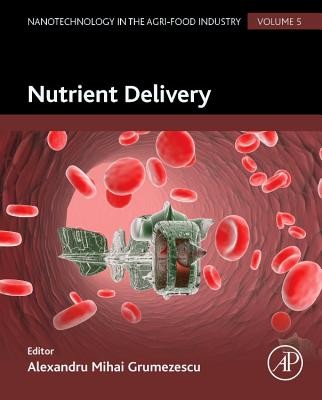
- Išsiųsime per 10–14 d.d.
- Leidėjas: Academic Press
- ISBN-10: 0128043040
- ISBN-13: 9780128043042
- Formatas: 19.1 x 23.5 x 4.5 cm, kieti viršeliai
- Kalba: Anglų
- Extra -15 % nuolaida šiai knygai su kodu: ENG15
Nutrient Delivery + nemokamas atvežimas! | knygos.lt
Atsiliepimai
Aprašymas
Nutrient Delivery: Nanotechnology in the Agri-Food Industry, Volume Five, discusses the fabrication, merits, demerits, applications, and bioavailability enhancement mechanisms of various nanodelivery systems. Recent developments in various nanodelivery systems are also highlighted. Volume 5 contains twenty chapters, prepared by outstanding international researchers from Argentina, Brazil, Canada, China, Croatia, India, Iran, Ireland, México, Pakistan, Portugal, Serbia, Sri Lanka, and the United States.
In recent years, the delivery of micronutrients at nanoscale has been widely studied as these systems have the potential to improve bioavailability, enable controlled release and enhance stability of food bioactives to a greater extent. The nanodelivery systems typically consist of the food bioactive compound encapsulated and stabilized in food grade ingredients such as lipids, proteins or polysaccharides with diameters ranging from 10 nm to 1000 nm. Among these, the lipid based delivery systems such as nanoemulsions, solid lipid nanoparticles, nanoliposomes and micelles are widely studied for the delivery of lipophilic bioactive compounds. These delivery vehicles improve the solubility, permeability, stability and bioavailability of the lipophilic compounds thereby enhancing their potential for oral delivery and functional food development.
On the other hand, the hydrophilic bioactives are delivered through protein, polysaccharide or biopolymer based colloidal nanosystems such as hydrogels, nanogels and polymer nanoparticles. The major concern other than solubility is the intestinal permeability of the micronutrients. For instance, the delivery system for compounds with poor intestinal permeability and low solubility need to be carefully designed using suitable lipids and surfactants.
EXTRA 15 % nuolaida
Kupono kodas: ENG15
Akcija baigiasi už 5d.20:45:27
Nuolaidos kodas galioja perkant nuo 10 €. Nuolaidos nesumuojamos.

- Leidėjas: Academic Press
- ISBN-10: 0128043040
- ISBN-13: 9780128043042
- Formatas: 19.1 x 23.5 x 4.5 cm, kieti viršeliai
- Kalba: Anglų
Nutrient Delivery: Nanotechnology in the Agri-Food Industry, Volume Five, discusses the fabrication, merits, demerits, applications, and bioavailability enhancement mechanisms of various nanodelivery systems. Recent developments in various nanodelivery systems are also highlighted. Volume 5 contains twenty chapters, prepared by outstanding international researchers from Argentina, Brazil, Canada, China, Croatia, India, Iran, Ireland, México, Pakistan, Portugal, Serbia, Sri Lanka, and the United States.
In recent years, the delivery of micronutrients at nanoscale has been widely studied as these systems have the potential to improve bioavailability, enable controlled release and enhance stability of food bioactives to a greater extent. The nanodelivery systems typically consist of the food bioactive compound encapsulated and stabilized in food grade ingredients such as lipids, proteins or polysaccharides with diameters ranging from 10 nm to 1000 nm. Among these, the lipid based delivery systems such as nanoemulsions, solid lipid nanoparticles, nanoliposomes and micelles are widely studied for the delivery of lipophilic bioactive compounds. These delivery vehicles improve the solubility, permeability, stability and bioavailability of the lipophilic compounds thereby enhancing their potential for oral delivery and functional food development.
On the other hand, the hydrophilic bioactives are delivered through protein, polysaccharide or biopolymer based colloidal nanosystems such as hydrogels, nanogels and polymer nanoparticles. The major concern other than solubility is the intestinal permeability of the micronutrients. For instance, the delivery system for compounds with poor intestinal permeability and low solubility need to be carefully designed using suitable lipids and surfactants.




Atsiliepimai